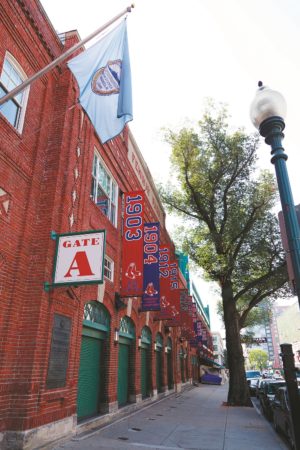It was a canny development decision that laid the foundation for one of the most remarkable transformations in the history of sports.
This is the fourth World Series for the Red Sox since a then-obscure hedge fund guru by the name of John Henry and Hollywood producer Tom Werner bought the Red Sox in 2001.
On the December day nearly 17 years ago when they emerged victorious from a $700 million-plus bidding war for the team, the new owners vowed to win not one, but multiple World Series. Their decision to renovate, not tear down, the old Fenway Park was a crucial step towards making that dream come true and ending an 86-year World Series drought.
Today Fenway is the ballpark other teams in baseball, and sports in general, wish they had, a sparkling, antique jewel revered by fans while generating a steady cash bonanza for the team’s front office.
A Bold Decision
The decision to renovate Fenway, instead of razing it to make way for a new and larger stadium, looks like a slam dunk in hindsight. But when Henry, Werner and their fellow investors bought the Sox in 2001, they faced more than a little skepticism over their plan to fix up Fenway.
The two main Sox owners were derided by some as carpet baggers without a clue about how to get things done in cynical, hard-bitten Boston, with Henry having previously owned the Florida Marlins while Werner, despite a stop at Harvard, was effectively a West Coast TV producer.
The consensus among Boston political, sports and business owners was that Fenway couldn’t be saved. The only way the Sox would ever get the cash to compete with the Yankees – and finally win the team’s first World Series since 1918 – was to scrap Fenway and build a cavernous new stadium packed with high-priced luxury seats.
A small clique of Yawkey family hangers-on ran the charitable trust that owned the team after the death of Jean Yawkey.
An accountant by trade, John Harrington, the executive in charge of the trust and the team, spent years pushing the idea that Fenway was in such terrible shape it couldn’t be saved, even winning a pledge of hundreds of millions of dollars in state and city support for a new stadium.
The new owners ditched that albatross of a plan, which would have required not just demolishing Fenway Park, but also seizing and leveling several acres of neighborhood businesses.

Scott Van Voorhis
Instead, Henry and gang brought in respected ballpark architect Janet Marie Smith, who had overseen the construction of Camden Yards, the Orioles’ charming, old-timey Baltimore ballpark.
Under Smith’s direction, the Sox restored Fenway to its original charm, while also finding a way to add a couple thousand badly needed new seats in ingenious places, such as top the wall of the green monster. Many of the new seats were high-priced luxury perches, providing a major financial lift for the Sox.
The team also expanded Fenway’s boundaries to the streets around the ballpark, which allowed the team to create a festival atmosphere around the park while earning millions more on hot dogs, beer, soda, T-shirts and other items.
The modest expansion turned out to be just the right size, allowing the Sox to add new seats while still profiting from a perception of ticket scarcity. By contrast, teams that embarked on much larger stadium projects have often wound up with too many seats that they are now struggling to fill. After all, there’s nothing like a camera pan of a half-filled stadium to depress ticket prices.
The Best Bargain in Baseball
The restoration and seating expansion, which took place over several years, ultimately cost the new Sox owners $285 million, roughly a quarter of what the Yankees spent to build their new Bronx stadium.
And the team has reaped an impressive return. Sox ticket revenue jumped $89 million in 2001, the year Henry and Werner’s ownership group bought the team, to $121 million in 2004 to $192 million this year. That’s third in Major League Baseball, behind only the Yankees and the Cubs.
It’s also pretty impressive given Fenway, built in 1912, has a capacity of 37,731, and is 25 percent smaller than the Yankees’ new, $1.1 billion stadium, which tops 47,000 seats and has more club and luxury perches.
The most telling matchup, though, is between Fenway Park and Dodgers Stadium, the home of their current World Series opponents.
While the Sox generate $192 million out of comparatively tiny Fenway, the Dodgers manage to get just $188 million out of their 56,000 seat stadium, which, not to rub things in too much, is more than 50 percent larger than Fenway.
And the Sox squeeze an amazing amount of money out of Fenway given the size of the Boston market compared to LA, New York and Chicago. Greater Boston is a fifth of the size of the New York area, a third of the size of Los Angeles and half the size of the Windy City and its environs.
When the dust settles after this year’s World Series, various Sox players and coaches will be lauded for their part in a standout season, whatever the ultimate outcome.
But none of it would have been possible without that decision years ago by the team’s owners to buck conventional wisdom and renovate Fenway instead of trying to build some large monstrosity.
The when it comes to the crucial category of dollars brought in to pay the players, Fenway Park is the true MVP.
Scott Van Voorhis is Banker & Tradesman’s columnist; opinions expressed are his own. He may be reached at sbvanvoorhis@hotmail.com.




 |
| 

